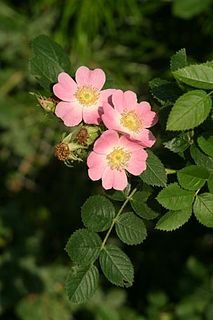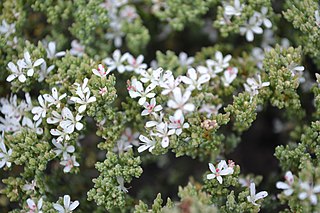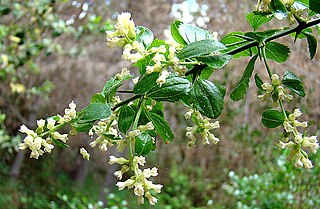
The rose subfamily Rosoideae consists of more than 850 species, including many shrubs, perennial herbs, and fruit plants such as strawberries and brambles. Only a few are annual herbs.

Discaria is a genus of 6 species of flowering plants in the family Rhamnaceae, native to temperate regions of the Southern Hemisphere, in Australia, New Zealand and South America.

Azorella is a genus of flowering plants in the family Apiaceae, native to South America, New Zealand, southeastern Australia, and the islands of the Southern Ocean.

Zizaniopsis is a genus of plants in the grass family, Poaceae, native to North and South America.

Anarthrophyllum is a genus of flowering plants in the legume family, Fabaceae. It belongs to the subfamily Faboideae.

Distichlis is a genus of American and Australian plants in the grass family. Plants in this genus are dioecious, have rhizomes or stolons, and have conspicuously distichous leaves.

Ortachne is a genus of Latin American plants in the grass family.
Ameghinoa is a genus of flowering plants in the daisy family, described in 1897 by Carlo Luigi Spegazzini.

Carlo Luigi Spegazzini, in Spanish Carlos Luis Spegazzini, was an Italian-born Argentinian botanist and mycologist.

Frankenia is the only genus in the Frankeniaceae family of flowering plants. Other genera have been recognized within the family, such as Anthobryum, Hypericopsis and Niederleinia, but molecular phylogenetic studies have consistently shown that they all belong inside Frankenia. Frankenia comprises about 70–80 species of shrubs, subshrubs and herbaceous plants, adapted to saline and dry environments throughout temperate and subtropical regions. A few species are in cultivation as ornamental plants.

Portulaca amilis, known as Paraguayan purslane, is a species of Portulaca native to South America. It was introduced to the southeastern United States and other countries around the world and can be found in sandy soil in disturbed areas, roadsides, fields, lawns and gardens.
Moschopsis is a genus of flowering plants in the family Calyceraceae, native to the mid-Andes of South America; Peru, Chile and Argentina. They are compact perennial succulents appearing somewhat like small heads of broccoli or artichokes.

Boopis is a genus of flowering plants in the family Calyceraceae, native to Chile, Argentina and Brazil. The taxon is believed to be highly polyphyletic.
Acanthocladus is a genus in the family Polygalaceae that is native to South America.
Chilocardamum is a small genus of four herbaceous cress-like species of plants in the family Brassicaceae, only found growing in Patagonia, southern Argentina.

Retanilla is a genus of flowering plants in the family Rhamnaceae, native to Chile, Peru, and Argentina. The species in this genus are actinorhizal plants.
Xerodraba is a genus of flowering plants belonging to the family Brassicaceae.
Trichotolinum is a genus of flowering plants belonging to the family Brassicaceae.
Aschersoniodoxa is a genus of flowering plants belonging to the family Brassicaceae.
Culcitium is a genus of flowering plants belonging to the family Asteraceae.











